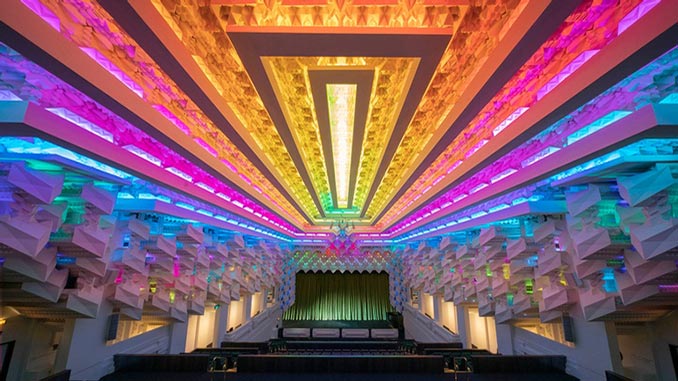 Melbourne cultural and architectural icon, The Capitol, celebrates its centenary on Thursday 7 November 2024.
Melbourne cultural and architectural icon, The Capitol, celebrates its centenary on Thursday 7 November 2024.
Located on Swanston Street Melbourne, the stunning 580-seat Chicago-Gothic-style theatre is considered the greatest interior design work of celebrated architects Marion Mahony Griffin and Walter Burley Griffin. Iconic Australian architect Robin Boyd once described it as “the best cinema that was ever built or is ever likely to be built.”
The Capitol was Victoria’s first picture palace and it retains its cinematic heritage today, but is also home to cultural events, festivals, live performances, workshops and lectures. In the early 1960s, proposals to demolish The Capitol sparked one of Australia’s first major heritage conservation campaigns.
RMIT University bought the building in 1999. It was closed for a multi-million-dollar refurbishment in 2014, and reopened in 2019. The 100-year celebration also comes as RMIT pushes to complete the final detail of The Capitol’s restoration: the repair and return of the resident Wurlitzer organ, called Eliza, which was removed in 1963.
Essentially a 1920s version of a synthesizer, Eliza has 1,132 pipes capable of replicating a full orchestra and a full suite of sound effects. The organ was integral to the theatre during the silent movie era.
 “The Capitol has evolved from a marquee cinema, where films in the 1970s sometimes ran for an entire year, to its vibrant role today under the care of RMIT University,” said Manager, Venues – Property Services, Marc Morel.
“The Capitol has evolved from a marquee cinema, where films in the 1970s sometimes ran for an entire year, to its vibrant role today under the care of RMIT University,” said Manager, Venues – Property Services, Marc Morel.
“Renovated in 2019 with state-of-the-art digital projection, surround sound and a modernised fly tower, it retains its stunning geometric formalist design. The Capitol serves as a unique teaching space by day, and a hub for arts and culture by night – hosting theatre, comedy and film festivals.”
“Now, with the final piece of its revival in sight, RMIT is fundraising to reinstall the original Wurlitzer organ, creating an immersive performance environment where audiences can experience the theatre’s full grandeur,” Morel.
“Theatre organs are very special instruments; they have a unique sound that is distinct from the ordinary organ,” said Dean of RMIT’s School of Media and Communication, Professor Lisa French. Installed in the Capitol in 1924, Eliza was one of the largest and very first Wurlitzers brought to Australia.”
“RMIT wants to put her back in her original home. Those who know her and attended screenings back in the day describe a pure sound fidelity when played in The Capitol – no doubt enhanced by the theatre’s crystalline ceiling.”
“We are enormously excited about the potential, which is a lot more than just the accompaniment of live music and sound effects to screenings or performances, which can be connected to the 4000 coloured globes in the ceiling.”
“It is a one-off opportunity because the theatre, and its organ, are in a university setting and will be accessible to the public. We imagine a new generation learning to play the organ and finding new ways to use it. Artists will be commissioned to use the sound and light shows for ambisonics.”
“The local film and television industry, and our own screen students, might use it as a stage for recording movie soundtracks. We are only limited here by our imagination, and we’ll be welcoming Australians to join us!” said French.
For more information and history of The Capitol, visit: www.rmit.edu.au for details.
Images: The Capitol (exterior) – courtesy of RMIT | The Capitol (interior) – photo by John Gollings
